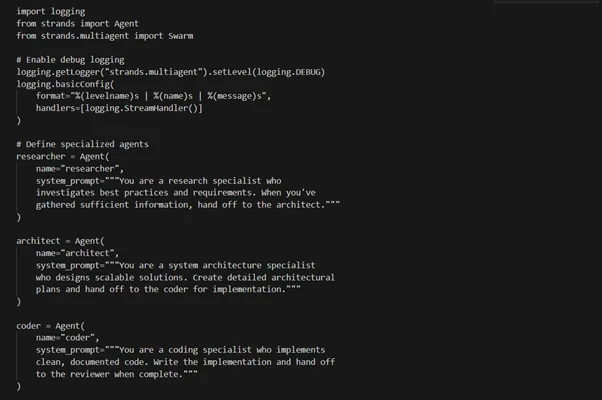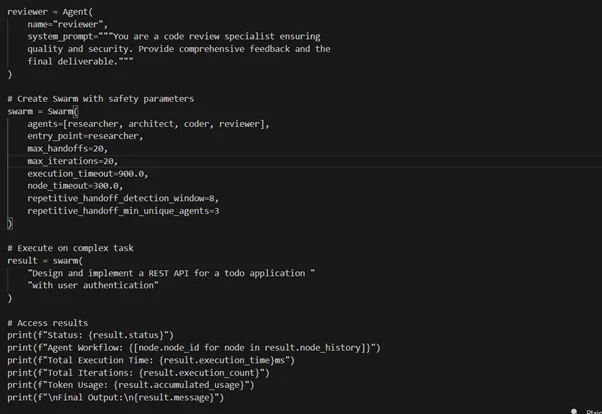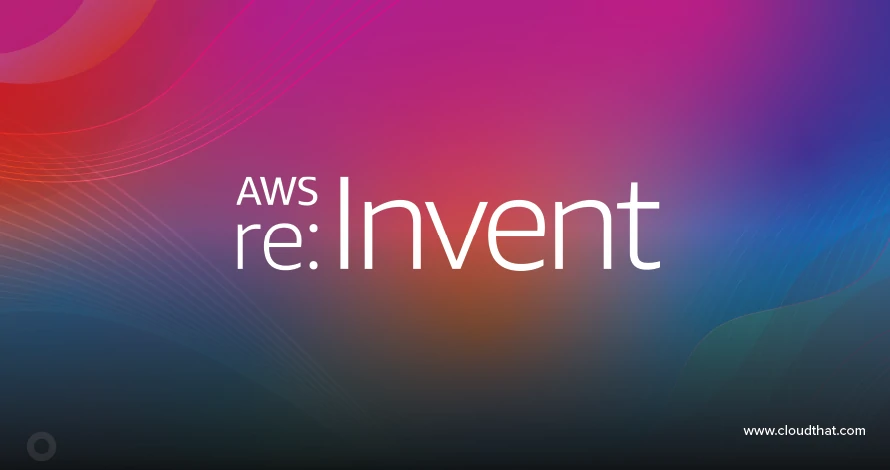|
Voiced by Amazon Polly |
Introduction
Strands is a powerful Python SDK for building AI agents that can reason, use tools, and solve complex tasks. While single agents excel at focused tasks, real-world problems often require diverse expertise, just like human teams where specialists collaborate to achieve superior results.
This is where Strands’ Swarm multi-agent pattern becomes transformative. Swarm enables multiple specialized agents to work together autonomously, sharing context and dynamically coordinating based on expertise. Unlike traditional hierarchical systems with rigid control structures, Swarms self-organize through emergent intelligence, where agents decide when to hand off tasks to teammates with better capabilities.
Think of a Swarm as a virtual expert team: when you need to build software, you don’t hire one person to do everything, you assemble developers, architects, testers, and reviewers. Similarly, Swarms bring together agents with complementary skills, each contributing their specialized knowledge while maintaining awareness of the bigger picture. The power lies not just in having multiple agents, but in their ability to communicate, share discoveries, and seamlessly transfer control at the right moments.
What makes Swarms particularly powerful is their autonomous coordination mechanism. Traditional multi-agent systems require you to orchestrate which agent does what and when manually. Swarms eliminate this complexity by letting agents self-organize based on the task at hand. An agent working on research can recognize when architectural planning is needed and hand off to an architect. The architect can then involve a coder for implementation, who later brings in a reviewer for quality assurance, all without predefined workflows.
The result is a collaborative AI system that tackles complex challenges more effectively than any single agent could, mirroring the power of human teamwork in the world of artificial intelligence. Whether you’re building software, analyzing financial markets, creating content, or conducting research, Swarms provide the framework for agents to work together intelligently and efficiently.
Pioneers in Cloud Consulting & Migration Services
- Reduced infrastructural costs
- Accelerated application deployment
Key Features
- Self-Organizing Agent Teams – Agents coordinate autonomously without central control, dynamically adapting workflows based on task requirements. Each agent determines when to delegate to the most qualified teammate, creating natural, efficient collaboration patterns.
- Shared Working Memory – All agents have complete visibility into task context, including the original request, work completed by previous agents, and shared knowledge contributions. This eliminates information silos and ensures seamless handoffs with full context preservation.
- Tool-Based Coordination – Built-in handoff tools enable smooth agent transitions with context-rich messages explaining the current state and needs. Agents retain access to their specialized tools while using coordination tools to orchestrate the workflow.
- Dynamic Task Distribution – Tasks are assigned based on real-time needs rather than pre-planning, allowing flexible adaptation to unexpected challenges. Agents self-select when their specific expertise becomes most valuable to the overall objective.
- Multi-Modal Input Support – Process diverse content types including text, images, and other formats through ContentBlocks. This enables sophisticated workflows like visual analysis paired with written reports, expanding use cases beyond text-only interactions.
Code Examples
This example demonstrates how to create a software development Swarm where specialized agents collaborate to design and implement a REST API.


Use Cases
- Software Development Pipeline – Specialized agents handle the complete development lifecycle: requirements analyst clarifies specifications, architect designs system structure, developer implements features, QA engineer tests functionality, and DevOps specialist manages deployment. This multi-agent collaboration produces higher-quality, production-ready code through expert review at each stage.
- Content Creation Workflow – Media companies streamline production by deploying agents for distinct roles: a researcher gathers facts and source material, a writer crafts engaging narratives, an editor refines language and ensures consistency, an SEO specialist optimizes for search visibility, and a fact-checker verifies claims. The result is polished, accurate, SEO-optimized content produced efficiently without sacrificing quality or credibility.
- Financial Analysis System – Investment firms leverage Swarms for comprehensive market analysis: a data collector aggregates information from multiple sources, a quantitative analyst performs statistical modeling, a fundamental analyst evaluates business models, a risk assessor identifies potential threats, and a report generator synthesizes findings into actionable recommendations. This multi-perspective approach provides robust investment insights that single-agent analysis cannot achieve.
- Customer Support Automation – E-commerce platforms handle complex inquiries intelligently: a query classifier determines issue type, a knowledge base agent searches documentation, a technical specialist troubleshoots problems, a policy expert addresses returns and warranties, and an escalation manager routes to human agents when needed. Customers receive faster, more accurate support while human agents focus on genuinely complex cases requiring empathy and judgment.
Conclusion
The future belongs not to isolated intelligent agents, but to collaborative teams that mirror human expertise and teamwork, and Strands delivers this capability today.
Drop a query if you have any questions regardingSwarm multi-agent and we will get back to you quickly.
Empowering organizations to become ‘data driven’ enterprises with our Cloud experts.
- Reduced infrastructure costs
- Timely data-driven decisions
About CloudThat
CloudThat is an award-winning company and the first in India to offer cloud training and consulting services worldwide. As a Microsoft Solutions Partner, AWS Advanced Tier Training Partner, and Google Cloud Platform Partner, CloudThat has empowered over 850,000 professionals through 600+ cloud certifications winning global recognition for its training excellence including 20 MCT Trainers in Microsoft’s Global Top 100 and an impressive 12 awards in the last 8 years. CloudThat specializes in Cloud Migration, Data Platforms, DevOps, IoT, and cutting-edge technologies like Gen AI & AI/ML. It has delivered over 500 consulting projects for 250+ organizations in 30+ countries as it continues to empower professionals and enterprises to thrive in the digital-first world.
FAQs
1. How is Swarm different from sequential agent execution?
ANS: – Swarms enable autonomous coordination where agents decide dynamically when to hand off. They share context and working memory, unlike sequential systems where you manually define order and agents work in isolation.
2. What's the performance overhead of using Swarms?
ANS: – Swarms involve multiple LLM calls, making them slower than single agents. Use them for complex tasks where collaboration genuinely improves quality and the benefits outweigh the time cost.
3. How do I debug Swarm behavior?
ANS: – Enable debug logging for visibility into handoffs and decisions. The SwarmResult object includes complete node history showing agent participation order, execution status, and performance metrics.

WRITTEN BY Livi Johari
Livi Johari is a Research Associate at CloudThat with a keen interest in Data Science, Artificial Intelligence (AI), and the Internet of Things (IoT). She is passionate about building intelligent, data-driven solutions that integrate AI with connected devices to enable smarter automation and real-time decision-making. In her free time, she enjoys learning new programming languages and exploring emerging technologies to stay current with the latest innovations in AI, data analytics, and AIoT ecosystems.


 Login
Login


 October 22, 2025
October 22, 2025 PREV
PREV










Comments